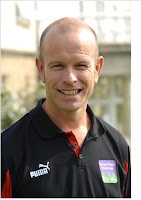Some products have become so ubiquitous that their name has morphed into a generic noun. I still find myself referring to 'Hoovers' years after their dominance in the world of vacuum clears has subsided (all hail the Dyson!). And I still talk quite freely about 'Durex' as a catch-all term for contraceptives, despite learning to my cost (and embarrassment and potential injury) that the word means sticky tape in Australia).
Some trademarks and brands have become completely absorbed into everyday language. You might be surprised to learn (as I was) that 'Aspirin' is not the name of a drug, but actually a proprietorial brand. And the same is true of Astroturf, Bubble Wrap, Hula Hoop, Frisbee, Ping Pong, and Jacuzzi.
Microsoft's Powerpoint is another case in point. In most Universities and schools, 'powerpoint' simply means presentation. And it is the most commonly used software, to the extent that departing from the norm can prove inconvenient or even impossible in many institutions. In fact, so all-pervasive is Powerpoint that not using presentation software at all - whether or not it is appropriate - is seen as the behaviour of a Luddite!
But there are good reasons to consider alternatives. The first is a political one: I suggest to you that conformity and obedience should be resisted as a matter of principle. It is our duty as free men and women (apologies to readers in North Korea). Breaking free of the heavy hand of Microsoft in schools and universities can be a daily dose of "anarchist callisthenics", that exercise the freethinking muscles!
A more fundamental reason to resist is that Powerpoint, like any software is a tool, and all tools have their inherent limitations. Use only kind of software and weaknesses quickly become acceptable, then normal, then inevitable. Introduce another type of software and choice suddenly becomes an option.
Powerpoint contains a remarkably comprehensive range of functions, but it is not as intuitive or pretty as Apple's Keynote (although you would also need to swap your PC for a Mac ... which is another great reason). It is also not non-linear nor as flexible as the online program Prezi. Nor is it free like Google's Drive presentation, PowToon, and 280 Slides.
If the intention is to do the same sort of thing as Powerpoint, but with a different look or feel, it is worth considering Sliderocket. If multimedia is your thing, then the new SlideSnack is excellent.
I'm not going to offer a proper review here. Nor will I dissect the virtues and vices of the different systems. My aim is to make a simple point: there is more to presentation software than Powerpoint, and it is well worth taking a little time to check out some of the alternatives.
In the era of web-based and cloud-based programs, the horny old 'PC versus Mac' question becomes somewhat redundant (the answer's Mac, by the way!). And many programs are offered free of charged, or at greatly reduced prices, so money is less of an obstacle that it once was.
So don't do it for me. Do it for your colleagues and friends who have had to suffer through countless hours of tediously similar slides and effects! Do it for those poor souls for whom the sight of a clever transition or animation no longer brings shrills of anticipation; just the deadening certainly that another bloody slide is coming along. Do it for those who still think that being told 'but we always do it this way' is reason enough to do something else!
Thursday, 29 August 2013
Thursday, 15 August 2013
Practically Perfect Presentations
The new school and university terms are approaching, so it is a good opportunity to reflect a while on the elements of excellent presentations.
With this in mind, I asked a few people with greater knowledge of the subject than me to share their words of wisdom. These are people whose work on this subject I respect and / or who I have seen live and thought "I wish I could do that!"
I would like to take this opportunity to thank them for contributing their thoughts. I hope you find their ideas as valuable as I do.

"Always respect your audience, and make sure you are well prepared for both the topic and the audience. So many people think they can 'wing it', and it is always obvious when they do!"

Andy Reed OBE, former Member of Parliament, now the Director of SajeImpact Ltd, works with a number of sports and charitable organisations, and is the chair of the Sport and Recreation Alliance. Andy wrote:
"Know who your audience are and what their knowledge and expectations will be.
"For me it's about sharing a passion for a topic and therefore being enthusiastic and authentic. It's about being aware of strengths and weaknesses and being prepared for different situations. I am poor at formal presentations without detailed notes, but prefer minimal notes/ PowerPoint when its more informal and a subject area I know well.
"Be prepared to alter direction.
"I always personally prefer Q&A as a large proportion of the talk - getting to understand what people want to know - it's about dialogue. Not just imparting everything you know!
"So know your audience, be yourself and authentic, prepare to the right level for the event, be authentic and engage."

Hiran Ilangantileke is an accomplished Musician and Public Speaker. He has trained, facilitated and presented to a wide range of audiences from Media companies to High Risk Organisations. As a professional commercial Musician he has engaged crowds of many thousands.
"My top tip for being a great presenter?…..Prepare for Presenting as you would for any major performance of skill.
"Consider the effort spent by an Athlete or Musician preparing for their, often, very public performance. An Athlete will know their event, a Musician their song and accordingly, a Presenter needs to know their material. This is Fundamental preparation, but is it enough to be a great communicator?
"To make presentations sparkle I often adapt a simple mental rehearsal technique from the world of sports. The best time to do this exercise is the night before your presentation, after you have revised your material.
- The most important step is to set a good psychological and physical state. For most people this means to relax, but choose the state you want to carry into the presentation and transmit to the audience. Ask yourself, what state or personal qualities will elicit the response that you want from the audience? e.g. if you want your crowd to be motivated/inspired/relaxed etc. what state should you be in? Your breathing rate is the foundation to your psychological and physical state, change your breathing – change your state.
"Enjoy your great performance!"
- Once you have set your desired state, close your eyes and mentally rehearse the presentation (performance) whilst all the time maintaining your state, as indicated by your breathing rate. Start the mental movie well before you’re in front of the audience. Rehearse everything from approaching the stage to leaving it. At all times whilst you are visualising, notice how your state supports your voice quality, recall of information, flexibility and overall, elicits the responses you want from the audience. It's okay if you don’t know what the room or audience looks like yet, just use your imagination. That said, it can be very powerful to run this technique whilst in the actual room you’ll be in the next day.

Dr David Morley, from Leeds Metropolitan University, is an outstanding workshop leader. He stressed the importance of building rapport with the audience from the very beginning of a presentation:
"Engage everyone with eye to eye contact in the first minute of the presentation."

Finally, Daniel Coyle is the author of the excellent The Talent Code, and one of the masters of communicating the art and science of outstanding performance. Daniel offered advice for putting mistakes into proper perspective:
"Always remember that mistakes aren't verdicts - they're information to help you make the next reach."
Subscribe to:
Comments (Atom)






